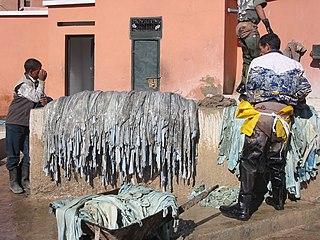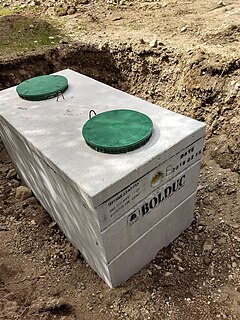Related Research Articles

Leather is a strong, flexible and durable material obtained from the tanning, or chemical treatment, of animal skins and hides to prevent decay. The most common leathers come from cattle, sheep, goats, equine animals, buffalo, pigs and hogs, and aquatic animals such as seals and alligators.

Tanning is the process of treating skins and hides of animals to produce leather. A tannery is the place where the skins are processed.

Waste management includes the processes and actions required to manage waste from its inception to its final disposal. This includes the collection, transport, treatment and disposal of waste, together with monitoring and regulation of the waste management process and waste-related laws, technologies, economic mechanisms.

A septic tank is an underground chamber made of concrete, fiberglass, or plastic through which domestic wastewater (sewage) flows for basic treatment. Settling and anaerobic processes reduce solids and organics, but the treatment efficiency is only moderate. Septic tank systems are a type of simple onsite sewage facility (OSSF). They can be used in areas that are not connected to a sewerage system, such as rural areas. The treated liquid effluent is commonly disposed in a septic drain field, which provides further treatment. Nonetheless, groundwater pollution may occur and can be a problem.

Environmental technology (envirotech), green technology (greentech) or clean technology (cleantech) is the application of one or more of environmental science, green chemistry, environmental monitoring and electronic devices to monitor, model and conserve the natural environment and resources, and to curb the negative impacts of human involvement. The term is also used to describe sustainable energy generation technologies such as photovoltaics, wind turbines, etc. Sustainable development is the core of environmental technologies. The term environmental technologies is also used to describe a class of electronic devices that can promote sustainable management of resources.

Ostrich leather is the result of tanning skins taken from African ostriches farmed for their feathers, skin and meat. The leather is distinctive for its pattern of bumps or vacant quill follicles, ranged across a smooth field in varying densities. It requires an intricate, specialised and expensive production process making its aesthetic value costly.
The Western Treatment Plant is a 110 km2 (42 sq mi) sewage treatment plant in Cocoroc, Victoria, Australia, 30 km (19 mi) west of Melbourne's central business district, on the coast of Port Phillip Bay. It was completed in 1897 by the Melbourne and Metropolitan Board of Works (MMBW), and is currently operated by Melbourne Water. The plant's land is bordered by the Werribee River to the east, the Princes Freeway to the north, and Avalon Airport to the west. It forms part of the Port Phillip Bay and Bellarine Peninsula Ramsar Site as a wetland of international importance. The Western Treatment Plant treats around 50% of Melbourne's sewage – about 485 ML per day - and generates almost 40,000 ML of recycled water a year.
This article discusses topics related to the environment of Pakistan.

Sewage treatment is a type of wastewater treatment which aims to remove contaminants from sewage to produce an effluent that is suitable for discharge to the surrounding environment or an intended reuse application, thereby preventing water pollution from raw sewage discharges. Sewage contains wastewater from households and businesses and possibly pre-treated industrial wastewater. There are a high number of sewage treatment processes to choose from. These can range from decentralized systems to large centralized systems involving a network of pipes and pump stations which convey the sewage to a treatment plant. For cities that have a combined sewer, the sewers will also carry urban runoff (stormwater) to the sewage treatment plant. Sewage treatment often involves two main stages, called primary and secondary treatment, while advanced treatment also incorporates a tertiary treatment stage with polishing processes and nutrient removal. Secondary treatment can reduce organic matter from sewage, using aerobic or anaerobic biological processes.

The leather manufacturing process is divided into three sub-processes: preparatory stages, tanning and crusting. All true leathers will undergo these sub-processes. A further sub-process, surface coating may be added into the sequence. The list of operations that leathers undergo vary with the type of leather.

Waste are unwanted or unusable materials. Waste is any substance which is discarded after primary use, or is worthless, defective and of no use. A by-product by contrast is a joint product of relatively minor economic value. A waste product may become a by-product, joint product or resource through an invention that raises a waste product's value above zero.

The environmental effects of paper are significant, which has led to changes in industry and behaviour at both business and personal levels. With the use of modern technology such as the printing press and the highly mechanized harvesting of wood, disposable paper became a relatively cheap commodity, which led to a high level of consumption and waste. The rise in global environmental issues such as air and water pollution, climate change, overflowing landfills and clearcutting have all lead to increased government regulations. There is now a trend towards sustainability in the pulp and paper industry as it moves to reduce clear cutting, water use, greenhouse gas emissions, fossil fuel consumption and clean up its influence on local water supplies and air pollution.

The Igualada Leather Museum, located in Igualada, Catalonia, was created in 1954 and was the first leather museum in Spain, and the third one in Europe. The collections are displayed in two nearby buildings in Igualada: the "Cal Boyer" building, a former cotton textile factory from the late 19th century, and the "Cal Granotes" building, an 18th-century tannery.
S.B. Foot Tanning Company is a leather production facility located in Red Wing, Minnesota. It processes leather for use in the crafting of shoes, boots, belts, and leather accessories. In 2010, the factory processed nearly 6 million linear feet of hides. S.B. Foot Tanning Company is a wholly owned subsidiary of Red Wing Shoes Company, Inc. and is the principal supplier of leather to their shoe manufacturing plants. The company also supplies over 1.5 million linear feet of leather for use in the production of military footwear per year, extending a tradition that began with World War I, when the tannery supplied boot leathers for the construction of soldier boots.
Eskilstuna Energy and Environment was established in 1993 as a municipality owned company with responsibility for the sales and distribution of electricity, district heating and cooling, water, sewage, waste handling, biogas and broadband in the municipal district of Eskilstuna, Sweden.
Karachi has many environmental issues, severely affecting its biophysical environment as well as human health. The industrialization as well as lax environmental oversight have contributed to the problems. The various forms of pollution have increased as Karachi which has caused widespread environmental and health problems. Air pollution, lack of proper waste management infrastructure and degradation of water bodies are the major environmental issues in Karachi.

The Kolkata Leather Complex is an industrial complex at Karaidanga, Bantala near East Kolkata, India. It is located 20 km from the central business district of Kolkata and has an area of about 4.5 square kilometres.

Chouara Tannery is one of the three tanneries in the city of Fez, Morocco. It is the largest tannery in the city and one of the oldest. It is located in the Fes el Bali, the oldest medina quarter of the city, near the Saffarin Madrasa along the Oued Fes. Since the inception of the city, the tanning industry has been continually operating in the same fashion as it did in the early centuries. Today, the tanning industry in the city is considered one of the main tourist attractions. The tanneries are packed with the round stone vessels filled with dye or white liquids for softening the hides. The leather goods produced in the tanneries are exported around the world.
The fashion industry is one of the major polluting industries in the world. The industry produces an estimated 10% of all greenhouse gas emissions. The production and distribution of the crops, fibers, and garments used in fashion all contribute to differing forms of environmental pollution, including water, air, and soil pollution.The textile industry is the second greatest polluter of local freshwater in the world, and is culpable for roughly one-fifth of all industrial water pollution. Some of the main factors that contribute to this industrial caused pollution are the vast overproduction of fashion items, the use of synthetic fibers, and the agriculture pollution of fashion crops.

Leather is created when an animal skin or hide is chemically treated in a process called tanning to preserve them for long term use as material for clothing, handbags, footwear, furniture, sports equipment and tools. Alligator leather is also commonly used to create similar items as mentioned above.